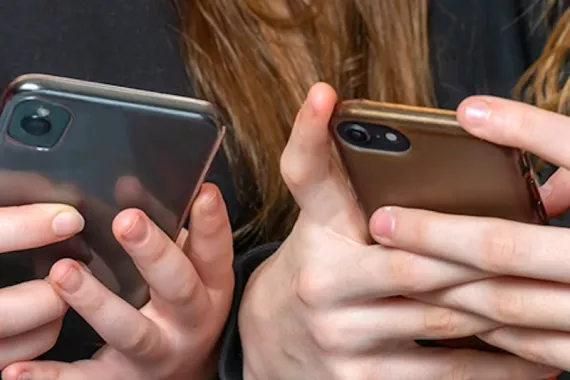
The Legal Team
- Andrew P. Arnold
- Ebony Williams Bobbitt
- Riley Breakell
- Abigail Burman
- Jessica L. Carroll
- Grace P. Chandler
- Jessica C. Colombo
- Sara O. Couch
- Nelson L. Drake
- Jade A. Haileselassie
- Mathew P. Jasinski
- Marlon E. Kimpson
- Annie E. Kouba
- Paul T. Lyons
- P. Graham Maiden
- Kate E. Menard
- Donald A. Migliori
- Lance Oliver
- Jonathan D. Orent
- Joseph F. Rice
- Tammy Cauley Rivers
Case Overview
Studies have found social media usage can lead to addictive behavior and serious negative consequences, especially for young people. This is because social media platforms are built to appeal to the reward centers of the human brain to keep us coming back. Read on to learn more about why social media is so addictive.
Key takeaways about why social media is addictive
- Lawsuits allege that social media developers may have deliberately designed platforms to be addictive to children.
- Researchers believe features such as infinite scrolling, likes and comments can keep children and teens on social media platforms by taking advantage of their underdeveloped impulse control.
- Addictive social media features can expose children to numerous mental and physical threats to their well-being.
What is social media addiction?
There’s no formal diagnosis for social media addiction or problematic use. But researchers have started studying excessive social media use by adapting six criteria common in discussing other types of addiction. These traditional criteria broadly reflect:
- Compulsion to use the product
- Continued use occurring at the expense of other things in the user’s life, such as their mental and physical health
- Excessive use of a product
Social media addiction scale
Researchers developed an addiction metric specifically for overuse of social media called the Bergen Social Media Addiction Scale (BSMAS). Experts derived the scale from criteria used to identify other types of addiction. Each metric measures how much the excess use of a product affects other aspects of a user’s life, such as their health.
This metric assesses a person’s social media habits on a scale of 1 (very rarely) to 5 (very often) for each item.
- Salience: How much time people spend thinking about social media and planning to use it
- Mood modification: How often users turn to social media to forget about other things in their lives
- Tolerance: How often people feel the urge to use a platform and whether that urge has increased
- Withdrawal: Uncomfortable impacts of not using social media (restlessness, racing thoughts, bad moods, etc.) and how bad they are
- Conflict: How much social media negatively affects a person’s day-to-day life (real-life mental health, relationships, job or studies)
- Relapse: How long it takes someone to return to using social media after trying to stop a social media addiction on their own
Using this scale can help determine the extent of a person’s use of social media and can help people seek treatment for their addiction to social networks while also helping medical professionals determine the best course of treatment. If you have a family member or other loved one exhibiting these addictive behaviors, it may indicate that it’s time to seek help.
Problematic use of or addiction to social media should be treated seriously. It can affect anyone, but platforms often target vulnerable groups like tweens and teens.
How is social media addictive?
According to experts, social media platforms exploit our brain chemistry and psychology to foster addiction. Researchers have identified intermittent reinforcement, dopamine secretion and flow states as factors that make social media addictive.
Plaintiffs’ attorneys are examining how social media app designers create these programs with features that compel users to keep users scrolling. They’re also drilling down into how using the programs might be more dangerous for children whose brains are still developing. Read on to explore reasons why social media is addictive.
Intermittent reinforcement
In many ways, social media apps work like slot machines: Both give users rewards and both are unpredictable. Gamblers and social media users don’t know when they’ll get the rush of hitting a jackpot. This encourages them to keep feeding coins into the slot machine or scrolling for the next gratifying “like.”
On social networking sites, the idea of being connected and entertained draws users in. They receive notifications, likes, comments, reposts and engagement. Account holders never know when these rewards are coming, though, so they have to use the social media apps over and over again.
Tweens and teens are at higher risk of social media addiction or problematic use because their developmental stages make them more susceptible to this reward feedback loop. The parts of their brain responsible for impulse control are not fully developed compared to an adult’s.
As New York University Professor Adam Alter has explained, using social media is “a little bit like taking a drug. As far as your brain is concerned, it’s a very similar experience. Now the reason why is because it’s not guaranteed that you’re going to get likes on your posts. And it’s the unpredictability of that process that makes it so addictive.”
Hormone secretion
Oxytocin and dopamine are colloquially known as the “happy hormones.” These neurotransmitters play an important part in how our brains experience rewards. When we become adolescents, we begin to receive a larger rush of these hormones whenever we have a positive social interaction. This includes receiving favorable attention on social media platforms.
Repeated activities that induce a dopamine release help create a stronger link between those activities and the happy feeling from the dopamine. With enough repetition, our brains may even release dopamine in anticipation of the activity — including using social media — not just during it. And even if we don’t have a positive interaction, the possibility that we might keeps us coming back.
Oxytocin is another hormone related to social media use. People’s brains release oxytocin when they use social media and messaging apps. Constantly chasing the happy hormone boost on social media can interfere with work, school, sleep and other important tasks.
Endless scrolling and flow states
Social media lawsuits argue that social media apps are designed to get children to scroll mindlessly. Mental health researchers often refer to this as a “flow state.” Children may be more susceptible to app features that enable them to scroll effortlessly. This is because they’re less able to make responsible decisions about their screen time.
A social media user might plan to use an app for only 30 minutes, but they might be unaware of how much more time actually passes while they use an app. This can impact the amount of time available for work, school, exercise, sleep and other important activities.
Children have less developed impulse control skills than adults. They will keep scrolling in a flow state in search of a dopamine release. Social media companies are aware that children are more vulnerable to the design of these algorithms and features. Big tech companies take advantage of this vulnerability and target children to maximize their revenue stream. They use features like endless scrolling and autoplay to make finding new content seamless, which makes it harder for users to stop.
Is social media designed to be addictive?
Social media addiction lawsuits allege that platform developers deliberately shaped their algorithms to remain addictive. Social media sites make money from collecting user information and selling ads, activities that are more profitable if users stay online longer.
Social media lawyers are working to prove that these platforms know exactly what they are doing. According to the plaintiffs’ allegations, platforms have designed their products to draw young people in and keep them coming back, so that they can collect more data from kids to protect their bottom lines.
What makes social media addictive are various features that concern experts, including:
Autoplay or infinite scroll: Video platforms like YouTube automatically play the next video in the queue or have an interface that never stops supplying content. This makes it easy to get into a flow state.
Notifications: Facebook and other social media platforms can alert users about new content, responses and likes. This plays on users’ fear of missing out (FOMO).
Shorts or Reels: Platforms like YouTube and Instagram often feature short content that’s easy to consume. Mental health experts argue that this targets children and their shorter attention spans.
Temporary content: Some platforms, like Snapchat, have content that disappears shortly after it’s posted. This encourages users to check the app often.
“Each Defendant [Meta, Snap, ByteDance, Google] has designed, engineered, marketed, and operated its products to maximize the number of children who download and use them compulsively. Children are more vulnerable users and have more free time on their hands than their adult counterparts. Because children use Defendants’ products more, they see more ads, and as a result generate more ad revenue for Defendants. Young users also generate a trove of data about their preferences, habits, and behaviors. That information is Defendants’ most valuable commodity. Defendants mine and commodify that data, including by selling to advertisers the ability to reach incredibly narrow tranches of the population, including children.”
- Social Media Harm Lawsuit Complaint Excerpt
What kinds of harm can social media addiction cause?
Social media addiction or problematic use can lead to mental health harm that also turns into physical harm. Here are some possible negative impacts of problematic use of social media.
Anxiety: A study of Americans ages 3 – 17 found a 27% increase in diagnoses for anxiety between 2016 and 2020. Some researchers believe that social media platforms are related to the growing number of childhood anxiety diagnoses.
Attention deficit hyperactivity disorder (ADHD): Researchers found “a strong correlation” between ADHD and social media addiction. They believe the dopamine-releasing features are a factor.
Depression: Mental health statistics show that teen depression started to rise in 2012, right around the same time that “likes” became common on social media platforms. Children and teens who use social media might risk more exposure to cyberbullying, which can lead to depressive behavior.
Eating disorders: A 2024 study linked time spent on social media to eating disorders and anorexia. The major finding was that each hour of screen time increases the odds of binge eating, fear of weight gain and behaviors to compensate for gaining weight.
Low self-esteem: Children and teens might lean on social media for validation through likes, comments and shares. But these features also allow negative feedback or cyberbullying that can put younger users’ self-image at risk.
Sleep deprivation: According to a 2022 American Academy of Sleep Medicine survey, 93% of Gen Z students say they’ve stayed up past their bedtime because of social media. Sleep deprivation is also linked to depression, obesity, suicidal ideation and substance abuse.
Frequently asked questions about addiction or problematic use of social media
Why am I addicted to social media?
Social media apps are designed to appeal to our brain chemistry and psychology. Apps like Facebook, Instagram, TikTok and Snapchat are seemingly designed to keep users engaged by preying on our brain's natural instincts and keeping us online or coming back for more.
Why would kids get addicted to TikTok?
TikTok utilizes a simple user interface focused around the platform’s “For You” feature that draws young users in and keeps them scrolling with minimal interruptions. A 2022 Pew Research Center survey found 67% of American teenagers use TikTok, with more than half (58%) using it daily. Parents have filed mental health lawsuits alleging TikTok addiction or problematic use has harmed their children.
Why is Instagram so addictive?
Meta, Instagram’s parent company, has designed the app interface to be highly engaging. One complaint against Meta says, “intermittent rewards keeps users endlessly scrolling in search of a dopamine release, oftentimes despite their desire to put their phone down and move onto other activities.” This complaint says overuse of Instagram can lead to problematic social media use.
Why is Snapchat so addictive?
Snapchat has one of the most unique app structures of the top platforms. It uses disappearing messages and “streaks” to create an artificial sense of urgency in its users. This can lead users to obsessively check the app for new messages and ensure their streaks continue uninterrupted.
Is YouTube addictive?
With its user-friendly interface, personalized recommendations and autoplay feature, YouTube appears designed to keep people engaged effortlessly. This can lead to addictive behavior or problematic use. Like other social media platforms, YouTube allows users to like and comment on content. High-profile YouTubers also cultivate relationships designed to appear authentic and personal, which can isolate young users from in-person friends.
Our technology and media litigation experience
Our law firm has years of experience helping families hold big tech companies accountable. Motley Rice attorney Previn Warren is co-lead counsel on the national mass legal action against social media companies like Alphabet (Youtube), ByteDance (TikTok), Meta (Facebook and Instagram) and Snap, Inc. (Snapchat). Motley Rice attorney Annie Koube is on the leadership committee of the California state consolidated litigation.
If you believe a social media company caused a mental health crisis for you or a loved one, we might be able to help you file a lawsuit.
Read more about our experience advocating against technology and media companies.
Eligibility
Who can file a social media harm lawsuit? Parents or guardians can file a lawsuit against social media companies on behalf of their minor children who suffered mental health harms such as suicidal ideation, eating disorders and depression requiring hospitalization. Young adults can also file a lawsuit if they were minors when their trauma was diagnosed or treated.
Key takeaways
What is social media addiction?
How is social media addictive?
Is social media designed to be addictive?
Frequently asked questions about social media addiction
Our technology and media litigation experience
- Sources
- Amen Clinics. 5 Most Addictive Social Media Features.
- American Psychological Association. Speaking of Psychology: Molecules and morals: Learning the link, with Paul Zak, PhD.
- Brown Undergraduate Journal of Public Health. What Makes TikTok so Addictive?: An Analysis of the Mechanisms Underlying the World’s Latest Social Media Craze.
- Cecilie Andreassen et al., The relationship between addictive use of social media and video games and symptoms of psychiatric disorders: a large-scale cross-sectional study, 30(2) Psychol.of Addictive Behav., 252-262 (2016), http://dx.doi.org/10.1037/adb0000160.
- Child Mind Institute. How Using Social Media Affects Teenagers.
- Child Mind Institute. Social Media and Self-Doubt.
- Carter B, Rees P, Hale L, Bhattacharjee D, Paradkar MS. Association Between Portable Screen-Based Media Device Access or Use and Sleep Outcomes: A Systematic Review and Meta-analysis. JAMA Pediatr. 2016;170(12):1202–1208. doi:10.1001/jamapediatrics.2016.2341
- Chu, J., Ganson, K.T., Testa, A. et al. Screen time, problematic screen use, and eating disorder symptoms among early adolescents: findings from the Adolescent Brain Cognitive Development (ABCD) Study. Eat Weight Disord 29, 57 (2024). https://doi.org/10.1007/s40519-024-01685-1
- Georgetown University McCourt School of Public Policy. Research Update: Children’s Anxiety and Depression on the Rise.
- International Journal of Environmental Research and Public Health. Addictive Features of Social Media/Messenger Platforms and Freemium Games against the Background of Psychological and Economic Theories.
- Keles B, McCrae N, Grealish A. A systematic review: the influence of social media on depression, anxiety and psychological distress in adolescents. International Journal of Adolescence and Youth. 2020 Dec 31;25(1):79–93.
- Loma Linda University Health. The impacts of social media on youth self-image.
- Montag C, Lachmann B, Herrlich M, Zweig K. Addictive Features of Social Media/Messenger Platforms and Freemium Games against the Background of Psychological and Economic Theories. Int J Environ Res Public Health. 2019 Jul 23;16(14):2612. doi: 10.3390/ijerph16142612. PMID: 31340426; PMCID: PMC6679162.
- NBC News. Social media is driving teen mental health crisis, surgeon general warns.
- Riehm KE, Feder KA, Tormohlen KN, et al. Associations Between Time Spent Using Social Media and Internalizing and Externalizing Problems Among US Youth. JAMA Psychiatry. 2019;76(12):1266–1273. doi:10.1001/jamapsychiatry.2019.2325
- Sachs Center. Social Media and Addiction.
- United States District Court Northern District of California. Amended Master Complaint.
- Yale Medicine. How Social Media Affects Your Teen’s Mental Health: A Parent’s Guide.
Start Your Motley Rice Consultation in Simple Steps
Submit Information
Call us or fill out our online form with the details of your potential case.
Case Review
Our team reviews your information to assess your potential case.
Case Consultation
Talk with us about next steps.


